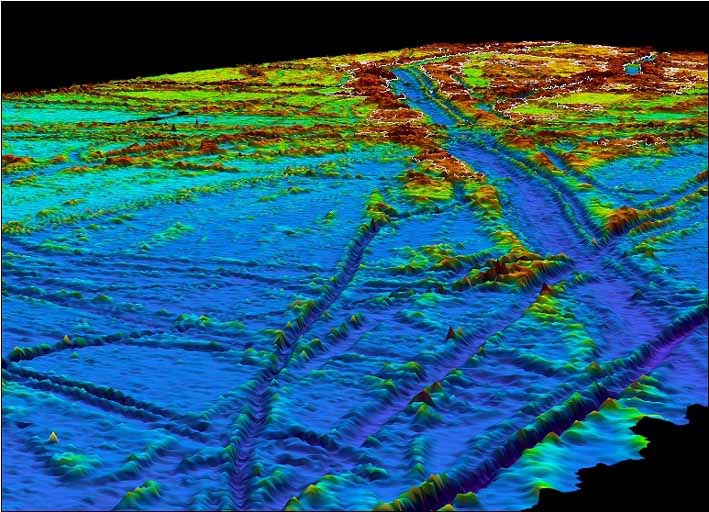
| MadSci Network: Earth Sciences |
Hello June and Neptune kids!
Icebergs are moved around by ocean currents and by wind. As most people have heard, the bulk of an iceberg is below the surface. How far below the surface they reach depends on the shape of the iceberg and how big it is, but according to this site on grounded icebergs, they can reach between about 300 and 500 metres below the surface!
Sometimes, the wind or current pushes an iceberg close to the shore and its bottom tip touches the bottom of the ocean. As the iceberg moves along, its bottom tip can gouge a trench in the ocean bottom - this is what we call scouring. Here's a picture of an iceberg that is scouring the bottom of the Beaufort Sea from the Beaufort Sea Geohazards Project:

As an iceberg scours along the bottom, it creates a long trench.
Depending on the direction that the iceberg is moving, and the topography
of the ocean bottom, it's possible that it will eventually get stuck, and
it will stay there until it thaws enough to continue to be moved along. If
an iceberg is located somewhere where there is sea ice in the winter, it
will also get frozen in for part of the year. So the creation of an
iceberg scour can take a very long time, an the iceberg gets stuck, thaws,
moves along, gets frozen in sea ice for the winter, and moves along again
in the spring, etc.
Iceberg scours are very persistant features. For instance, there are
still iceberg
scours off the coast of New Jersey (warning: pdf file) that have been
there for about 20000 years! Here's another picture of some iceberg
scours, also from the Barents Sea, viewed with multibeam acoustics
(multibeam acoustics are a very fancy kind of depth sounder that allows one
to make "maps" of the ocean bottom):

The colour of the image is related to depth, with the cool colours being deeper and the hot colours shallower - it's basically an image of the ocean bottom made with sound. You can see that not only are there several scours, but they are of various sizes. They can also change direction quite abruptly - you can see that the biggest scour in the picture turns about 45o to the right at the top of the picture. As you might expect, these scours can have a big impact on the plants and animals that live on the sea bottom in those areas!
Rob Campbell, MAD Scientist
Try the links in the MadSci Library for more information on Earth Sciences.